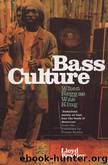Bass Culture: When Reggae Was King by Lloyd Bradley

Author:Lloyd Bradley [Lloyd Bradley]
Language: eng
Format: epub
Published: 0101-01-01T00:00:00+00:00
13
Wake the Town, Tell the People
One evening in early 1973, the deejay Big Youth was on stage rocking the house at Kingston's Carib theatre. Midway through his set, during one of his vibrant hymns to Jah Rastafari, the effervescent performer yanked his tam from his head and flashed his dreadlocks. Unlike a later Dillinger tune, there was no lightning clap, and the weakheart might well have stayed standing, but that was about all that didn't happen. The effect on the audience was electrifying. According to one observer:
‘When Jah Yout’ shake him head and flash him locks, which were quite long even then, there was complete silence for a second or two, then pure pandemonium… a noise that, I swear, actually shook the building. Everybody jus’ went wild. Any man with dreadlocks follow Jah Yout’ and flash ‘im locks too, while the other people jus’ cheer like they going to burst. I never heard noise like that, from any audience anywhere. But it was the first time, ever, the people had seen dreadlocks on stage somewhere like the Carib theatre. The effect was like… Joshua at the walls of Jericho.’
It seems remarkable that, given the proliferation of dreadlocks in 1970s reggae, as late as 1973 this action could produce such a reaction. But the man in the crowd was right – nobody had ever done that before. Although the more dedicated dreads had been growing locks for well over a decade, this was far from universal and yet to make virtually any sort of inroad into the music business. Of the Wailers at this stage, only Bunny had anything that could come close to being flashed – check the Catch a Fire sleeve or the family portrait mural on the wall at 56 Hope Road which was copied from a photo taken about 1972 or 73: Bob was only just starting to let his Afro nat up at the ends, while Peter had yet to get his locks going at all. There are hardly any dreadlocks on show in The Harder They Come, and of the acts that were making the most radical roots music, only the Abyssinians were noticeably locksed.
Even a year into Michael Manley's apparently populist regime remember this is the man who came to power waving a walking stick given to him by Haile Selassie while riding the roots-reggaefied Musical Bandwagon – dreadlocks were social outcasts. A leper colony would probably have qualified as a holiday resort compared to the sort of purgatory Rastas found themselves condemned to by the forces of law and order, most branches of bureaucracy and the ‘respectable’ public at large. To wear natty dreads was to set yourself up for pariahty, and the music business establishment went along with this. Promoters weren't likely to book openly dread acts for stage shows; clubs and band leaders were equally disinclined to employ Rasta musicians; Byron Lee was never keen on dreads in his Dynamic Studios, even though he himself was seldom there; Boris Gardiner sacked
Download
This site does not store any files on its server. We only index and link to content provided by other sites. Please contact the content providers to delete copyright contents if any and email us, we'll remove relevant links or contents immediately.
The Goal (Off-Campus #4) by Elle Kennedy(12440)
Kathy Andrews Collection by Kathy Andrews(10537)
Diary of a Player by Brad Paisley(6869)
What Does This Button Do? by Bruce Dickinson(5532)
Assassin’s Fate by Robin Hobb(5249)
Big Little Lies by Liane Moriarty(4888)
Pale Blue Dot by Carl Sagan(4014)
Sticky Fingers by Joe Hagan(3456)
The Heroin Diaries by Nikki Sixx(2938)
The Death of the Heart by Elizabeth Bowen(2908)
Beneath These Shadows by Meghan March(2723)
The Help by Kathryn Stockett(2705)
Confessions of a Video Vixen by Karrine Steffans(2678)
How Music Works by David Byrne(2532)
Jam by Jam (epub)(2491)
Harry Potter 4 - Harry Potter and The Goblet of Fire by J.K.Rowling(2417)
Strange Fascination: David Bowie: The Definitive Story by David Buckley(2369)
Petty: The Biography by Warren Zanes(2240)
Darker Than the Deepest Sea by Trevor Dann(2211)
